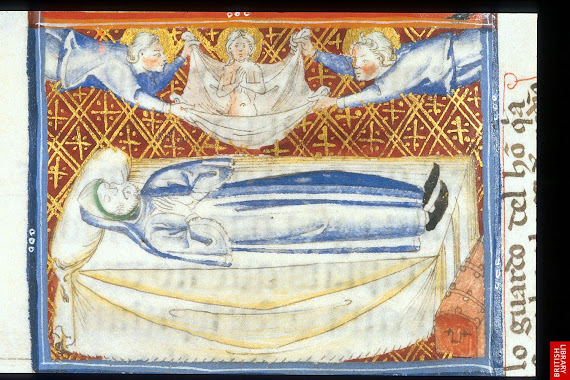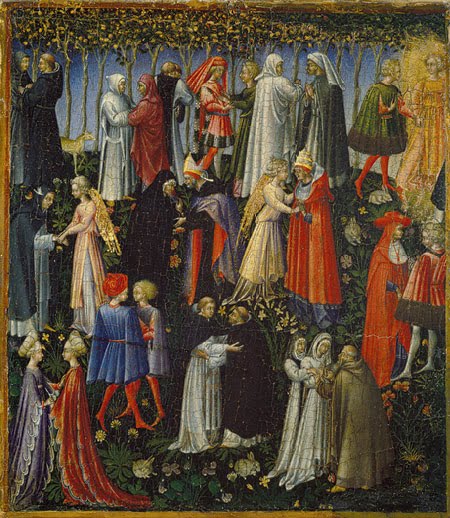Sources to Art Works in Historic Christianity
Walter Oakeshott, Classical Inspiration In Medieval Art, (NY: Frederick A. Praeger, 1959), plate 80: "A Carolingian ivory masterpiece: France, 9th cent." Ascension of Christ into heaven, hand of God the Father greeting Christ.
Hanns Swarzenski, (2nd ed.), Monuments of Romanesque Art, (Un. of Chicago Press, 1954 & 1967), plate 66, fig. 151. Late 10th cent.: "Christ in Mandorla" for rebirth, or as passage into another realm. Hand of God clasps the wrist of the Son, while an angel clasps hand of Christ.
Early Christian Art, The Late Roman & Byzantine Empires from the 3rd to the 7th century, fig. 83. Venice, St. Mark's 5th cent. Christ in Limbo. Adam reaches around a pillar to clasp right hand of Christ.
W. F. Volbach & Max Hirmer, Early Christian Art, (Pub. A Abrams), 93, Munich, Bavarian National Museum, ivory panel, Christ ascending into heaven, cent. 400. God right hand clasping right hand of Christ.
Early Christian Art, ibid., The crucifixion. Late 11th or early 12th century. Ivory. Treasure of the Cathedral of Saint Just, Narbonne.
Walter Lowrie, Art In The Early Church, 1947, plate 100. Christ descent into limbo, 4th or 5th cent.
Joseph Gantner & Marcel Pobe, Romanesque Art In France, (Thames & Hudson, 1956), plate 135, p. 64. Conques (Aveyron), Christ as Judge. See also: Roland H. Bainton, The Horizon of Christianity, (American Heritage Pub. Co., 1964), p. 214-15. Peter clasping hands of souls on right hand side of Christ as judge.
Andrew Martindale, Gothic Art, From the 12th to 15th century, (NY: Praeger, 1967), p. 132 & 133, Illustration 98: Belleville Breviary from the workshop of Jean Pucelle; probably between 1323 & 1326. Arm of God clasping hand of a person.
New Catholic Encyclopedia, vol. 21, p. 809, fig. 2-b. Old Testament prefigurations of Marriage, fragments of a Flemish silk & wool. Seven Sacraments. Tapestry from the workshop of Pasquier Grenier, Tournai, 3rd quarter of 15th cent.
Claude Schaeffner, Artistic Consultant: Jean-Clarence Lambert & others, Gothic Painting I, p. 48, (England: Ed. S.A. Geneva 1968. Master of Westphalia 14th century. Christ in Purgatory, Wallraf-Richartz Museum, Cologne. Christ grasping Adam by his hands. See also: The Lost Books of The Bible & The Forgotten Books of Eden, (Alpha House, 1926 & 27), p. 86-88, "The Gospel of Nicodemus." Also: A Library of Fathers of the Holy Catholic Church, vol. 2, p. 264-5, S. Cyril of Jerusalem, Lecture On the Mysteries.
Art A History of Painting, Sculpture, Architecture, vol. 1, p. 327, fig. 410. Benedetto Antelami. Descent from the cross. Relief. 1178. Cathedral of Parma, Italy, "...the lifting of Christ hand from the Cross becomes an act of ritual grace, accomplished with the aid of an angel."
Jean Porcher, Medieval French Miniatures, 38- The anumciation, 2nd half of the 12th cent. In the temple. Luke 1:10-11.
Hanns Swarzenski, Monuments of Romanesque Art, (Un. of Chicago Press, 1954 & 1967), plate 15, fig. 35, the ascension, Lorraine, cent. 1000. Hand of god extends down from heaven to grasp the hand of Christ.
Interesting Possible Connections between Christianity & the Mayans
The ascension into heaven, in historic Christian art, is also connected to deification = becoming divine, or gods! It was part of their earlier Christian mysteries too.
Here's some other examples to check out:
The Ascension, Northern French ivory carving work, about 1160-70 AD, the right hand of the Father extends down to grasp Christ's right hand, during Christ's ascension into heaven.
Christ's Ascension, Drogo Sacramentary (Paris BN lat. 9428), 9th cent. The right hand of the Father extends down to grip the right hand of Christ, as Christ stands on a small hill. (L'Ascension 40 jours après la résurrection de Pâques Jésus caché par une nuée s'élève dans le ciel IXe siècle Bibliothèque nationale Paris).
Ancient American cases:
There's even cases where ancient American "gods" ascend, with helping hands, in "resurrection" depictions, such as the
Corn God being resurrected with the help of the head band twins. (Susan Milbrath, Star Gods of The Maya, Astronomy In Art, Folklore & Calendars, (Texas Un. Press, 1999), 100-1, fig.3.11), Late Classical Vessel, Corn God Resurrected by Head Band Twins, Mayan art work).
An interesting Mayan work on a bowl shows another ascension out of the underworld, a hand extends down with a wound(?), or dot (death spot on the hand?), it grasps the right hand of the one ascending. (
974 bowl Veracruz during the Classic Period 300-900 AD, wounded hand clasp?)
In the Book of Mormon, 3rd Nephi 8:5, during the first few days of a new year, the 34th year, the 4th day, a great storm (volcano?) arose, the earth shakes, a vapor of darkness blocks out even the sun light. 1 Month, year 34, 4th day, or 1-4-34. Three days later, 1-7-34, the people hear the voice of God calling out to them to repent, etc. (3rd Nephi 8:23; 9). About a year later, towards the end of the 34th year, Christ appears to people at the temple, which was in the land Bountiful, & invites them to come forth & feel his wounds, (3rd Ne.10:18, 11:1-17). What is interesting to me is the traditions that Mayans & other native Americans have about a bright wounded wandering God, who appeared & promised to one day return. In the Mayan calendar system,
7 manik matches up with day 7 of a new year. Manik is a hand symbol that looks like it is grasping. Note again, that it's for DAY 7!
It looks like the hand is wounded or is cut off.
7 in Mayan count, rolls around on the wheels to line up with a line or bar with 2 dots, for #7. Note, grasping hand, day 7, of a new year. This is when the resurrected Christ was starting his world wide visits all around the world. He kept appearing to different people for some time, after his resurrection. Then, towards the end of the 34th year, it was the people at the temple in the land of Bountiful's turn:
"Arise and come forth unto me, that ye may thrust your hands into my side, and also that ye may feel the prints of the nails in my hands & feet,..." says the resurrected Christ to the ancient Americans, (3rd Ne. 11:14). I believe there must be a connection with all these art works that testify of the memory of Christ as not only the wounded Son of God of the Old World, but also the wounded Son of God of the New!








,+France,+Paris,+XVe.jpg)











+Harrowing+of+Hell..jpg)










 Hannah Rebekah (An On line LDS Apologist & fellow research/writer), has sometimes teamed up with Justin Martyr Jr on Topix to deal with a lot of anti-LDS posters. Critics don't like them because of how they also present a lot of information with a lot of sources to back up their claims. Here's her most excellent blog on Temple Studies, early Christian art that relate to the restored gospel).
Hannah Rebekah (An On line LDS Apologist & fellow research/writer), has sometimes teamed up with Justin Martyr Jr on Topix to deal with a lot of anti-LDS posters. Critics don't like them because of how they also present a lot of information with a lot of sources to back up their claims. Here's her most excellent blog on Temple Studies, early Christian art that relate to the restored gospel).






No comments:
Post a Comment